› Forums › Variable Stars › Nova in Hercules
- This topic has 50 replies, 23 voices, and was last updated 1 year, 2 months ago by
 Gary Poyner.
Gary Poyner.
-
AuthorPosts
-
13 June 2021 at 11:47 am #584353
 Robin LeadbeaterParticipant
Robin LeadbeaterParticipantProf Steve Shore comments on the evolution of Nova Del 2013 based on amateur spectra here. Not simple though !
http://www.astrosurf.com/aras/novae/Nova2013Del-1.html
Cheers
robin
13 June 2021 at 8:05 pm #584345Philip Jennings
SpectatorAt 23:45 UT I’m getting 6.4 (+/-0.2)V in my 10×50 binos, with reference to the 10deg chart. Transparency not great here so I only had a brief window to make an estimate – I seem to be in the one part of the country with cloud! But a really easy binocular target. Great to see the spectra on here.
13 June 2021 at 11:39 pm #584354 Daryl DobbsParticipant
Daryl DobbsParticipantIt’s faded quickly, this time last night (21:50UT) I could easily see it in 15×70 binocular, now I can’t pick it up. I’ll wait until it gets a bit darker
abandoned at 22:38UT as a bank of cloud has appeared
13 June 2021 at 11:48 pm #584355 MarkParticipant
MarkParticipantPicked it up quite easily in our RC8 🙂
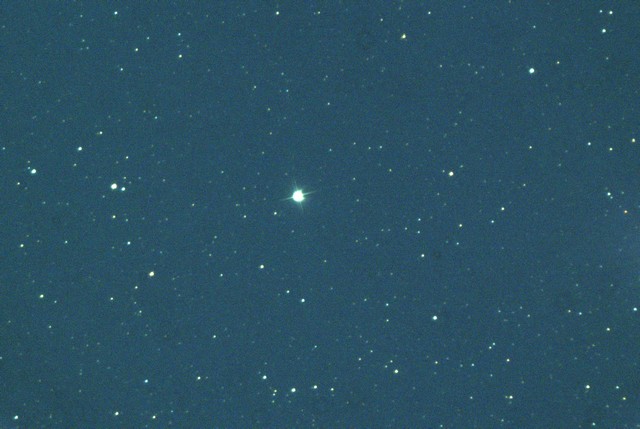 13 June 2021 at 11:51 pm #584356
13 June 2021 at 11:51 pm #584356 MarkParticipant
MarkParticipantI also had a go at a spectrum. As another poster noted, there doesnt seem to be much excess red.
This is the raw spectrum, not corrected for IR or atmosphere, compared to the refreence star Okab (type A0IV)
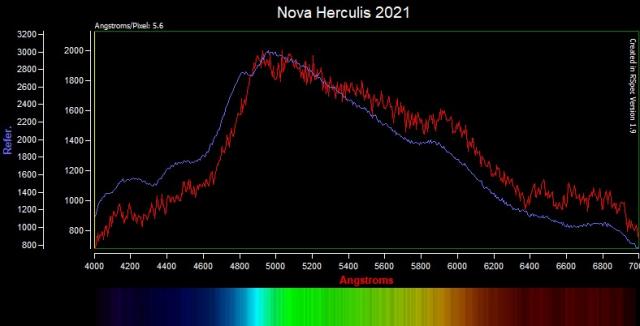 14 June 2021 at 12:21 am #584357
14 June 2021 at 12:21 am #584357 Nick JamesParticipant
Nick JamesParticipantI’ve just measured it as 7.54 (2021 June 13 22:51) compared to 5.94 at this time last night. Both unfiltered ref to Gaia DR2 G so somewhere between V and R. That’s a fall of 1.6 mags in day. That’s pretty fast. I remember photographing V838 Her (George Alcock’s last nova) in 1991 but only getting it on one occasion since it faded so fast.
14 June 2021 at 12:50 am #584359 David BoydParticipant
David BoydParticipantThe spectrum now looks very different from last night with strong and very wide Balmer emission lines.
David
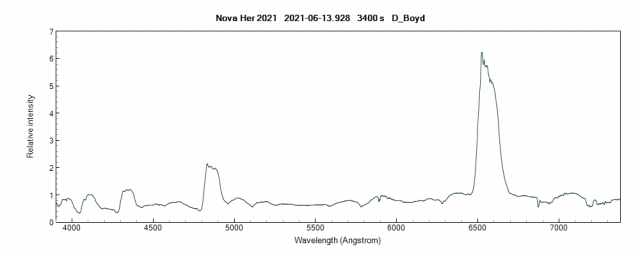 14 June 2021 at 1:31 am #584360
14 June 2021 at 1:31 am #584360Philip Jennings
SpectatorI have it at around 7.5V in 10×50 binoculars tonight (00:10 UT) – strikingly dimmer than comp. star 71 in the AAVSO chart (mag. 7.1), and only visible with averted vision although transparency isn’t perfect here. I had got my Star Analyser and C8 at the ready to capture a lo-res spectrum, but the clouds have promptly rushed in each time I have made an attempt.
I am intrigued by how quickly the spectrum seems to have changed from P Cygni profiles to hydrogen emission. I‘m guessing we were looking through the initial expanding envelope of ejected material yesterday and now we’re seeing ’deeper’ into the nova, to emission from runaway fusion etc? The pace at which these things can evolve amazes me.
14 June 2021 at 7:13 am #584361Paul Sutherland
ParticipantI took an unguided 10-second exposure at 0057 UT today with a FujiFilm X-T10 and 85mm Samyang lens. The nova had clearly faded. It appeared quite reddish compared to other stars. This image is reduced in size.
14 June 2021 at 8:02 am #584358 Mike HarlowSpectator
Mike HarlowSpectatorYes, much fainter than I was hoping for but still bright enough for a low resolution spectrum:
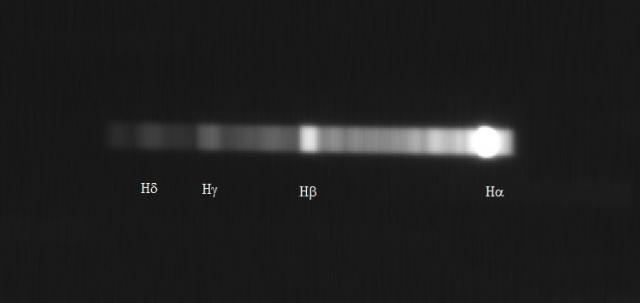
Very broad hydrogen lines dominated by H alpha emission.
Mike.
[26cm, 3 degree objective prism on 30cm F/6.8 astrograph. 6 x 15 seconds at ~23:30BST 13th June 2021]
15 June 2021 at 6:15 am #584362 Nick JamesParticipant
Nick JamesParticipantCBET 4977 has designated this nova as V1674 Her.
15 June 2021 at 8:27 am #584363 Peter MulliganParticipant
Peter MulliganParticipantMon June 14 23:35UT I get the Nova at 9.0m using the 8.5 and 9.4 comparison stars IRIS was used for Aperture photometry
Peter
16 June 2021 at 10:00 am #584366Anonymous
Inactive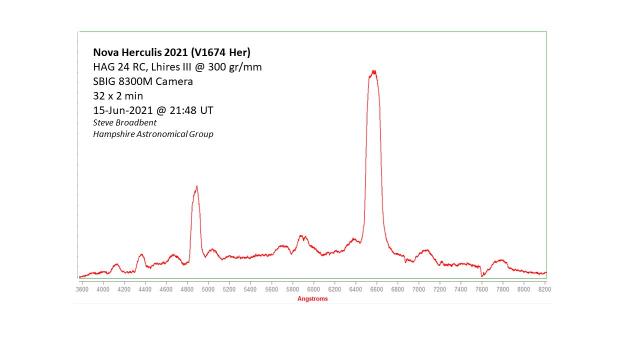 16 June 2021 at 10:30 am #584368
16 June 2021 at 10:30 am #584368 Paul G. AbelParticipant
Paul G. AbelParticipantObserved the nova last night, I made it about 9.4. I also noted a strong reddish colour- possibly the reddest nova I’ve ever observed!
16 June 2021 at 12:04 pm #584369 Robin LeadbeaterParticipant
Robin LeadbeaterParticipantA nice collection of spectra building up here in the Spectroscopy Database showing the evolution
The shift in the H alpha line from predominantly blue to red while still centred on the rest wavelength is curious. I wonder what that means physically
Cheers
Robin
16 June 2021 at 5:34 pm #584370 David BoydParticipant
David BoydParticipantFurther to Robin’s posting, the following plot shows the change in absolute flux of the nova over the last 4 days. These R~1000 spectra have been calibrated in absolute flux using concurrently recorded V magnitudes of 6.35, 8.38 and 9.77 respectively as described here.
David
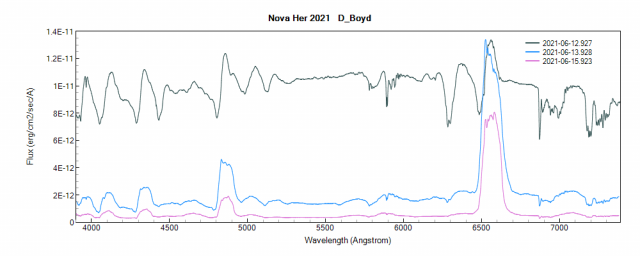 16 June 2021 at 8:13 pm #584371
16 June 2021 at 8:13 pm #584371Padraig Houlahan
ParticipantI’ve been dusting off the cobwebs concerning this very fascinating but confusing topic and found a nice – if older – overview in http://articles.adsabs.harvard.edu//full/1992AJ….104..725W/0000726.000.html that I have been reading. I found it very helpful and I’ve summarized its main points here. What I like about this article is it does a nice job of trying to connect the squiggly lines found in spectra to the real world physics. Here’s a very light (no pun intended) summary…
Spectroscopically, novae can be divided into two main types – those with ionized iron lines (FeII) and those with Helium/Nitrogen lines.
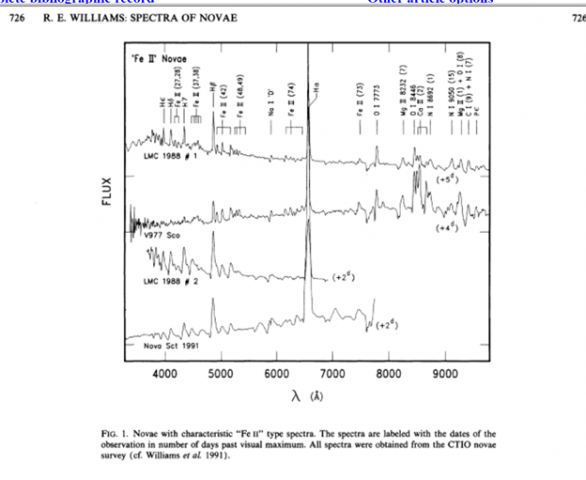
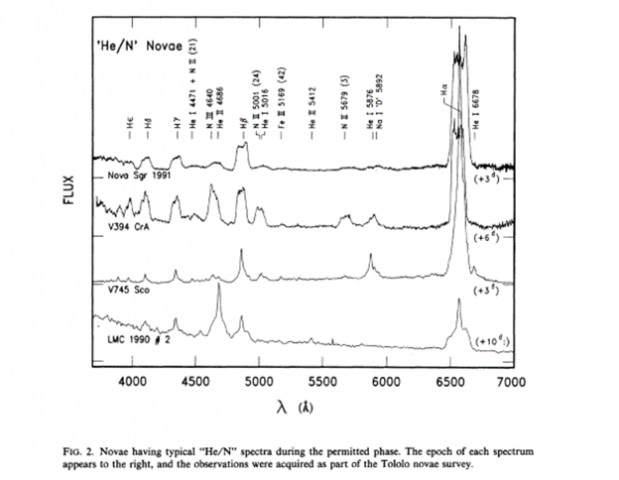
A given nova can have a spectrum that changes from one type to another.
Like certain supernovae, a nova forms in a binary system where matter builds up on a white dwarf – stolen from a companion star. If this accreted material ignites in a nuclear sense, it can form a nova. If the WD is sufficiently massive, (about 1.4 Msun) it can totally destroy itself and become a supernova. This kind of supernova, formed by the explosion of the same amount of matter (e.g., same number of sticks of dynamite since it always blows at 1.4 Msun), has a standard energy output and can then serve as a standard candle. In a nova, the WD is not destroyed.
The ejected material is in the form of a shell with a wind.
The shell has a high velocity and so its density drops rapidly.
Residual accreted material on the surface of the WD can continue burning gently.
Emission lines form in both the shell and the wind. Shell lines tend to be flat-topped; wind lines tend to be sharper and can have absorption line components.
If the winds are weak, the photosphere is close to the radius of the WD and its effective temperature is high. This creates higher ionization rates in the shell and produces He/N emission lines.
If the winds are strong, the photosphere is expanded, so its effective temperature is reduced, so the shell is less ionized, and much of the emission is from the wind (Fe II lines)
Different energies are needed to excite the different lines in the Balmer spectrum with H-alpha requiring the least. The closer the source region is to the hot surface, the higher the excitation possibility, so H-gamma is from deeper into the star than H-alpha etc.
As temperature is increased from zero… Collisions among atoms can bump electrons to higher orbits, from which they can fall and emit discrete line spectra. Hotter, and the atoms can be ionized – one or more electrons torn from atoms. As density drops, electrons can recombine with atoms and then cascade down through different lower levels; at higher densities, collisions might be driving electron back up, only to cascade back down.
From wikipedia… the Clasic P Cygnii line profile is essentially caused by the doppler effect acting on regions with different velocities. Emission lines coming from the wind, closer to the star and therefore with reduced velocity have minimal doppler change, while absorption from the shell – further out, closer to the observer, and approaching faster – involve shorter wavelengths; so a ‘line’ has both an emission part, and an absorption part at a slightly reduced wavelength. The separation between the absorption and the emission parts tell about the velocity differences. (More comprehensive explanations are available, but this seems good enough for now; the larger point is P Cygnii line profiles indicate the presence of an outflow of material.)
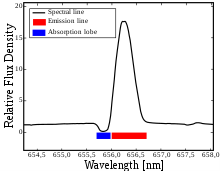
So, with this very brief summary, we can see the shapes of lines (P Cygnii, Flat, Narrow) informs us about whether the light is coming from a shell or the wind, and the presence of mass outflows. The presence of FeII vs He/N about winds and shells, and whether the winds are strong or weak, and the changes in the spectrum track how the nova is evolving with time.
So, there is a very strong connection between the wiggly lines of spectra and the underlying physics!
17 June 2021 at 8:49 am #584373 Jeremy ShearsParticipant
Jeremy ShearsParticipantKato-san (VSnet) notes that t3 (time to drop 3 mags) is ~ 2.3 days. Appears to be record breakingly fast!
17 June 2021 at 10:33 pm #584378 Richard SevernParticipant
Richard SevernParticipantJeremy Shears gave us a great round up on the Nova at the start of our local society meeting tonight. Watch it at https://youtu.be/OhWkoHpXnBg Also James Dawson and Sandra Brantingham gave a talk on noctilucent clouds.
17 June 2021 at 10:51 pm #584379 MarkParticipant
MarkParticipantAs of 2021-06-15T22:11:36 i measured it at mag 9.8 which is quite a drop in brightness!
-
AuthorPosts
- You must be logged in to reply to this topic.
